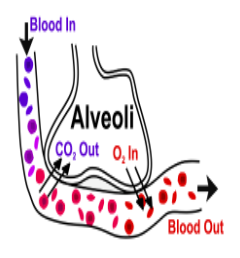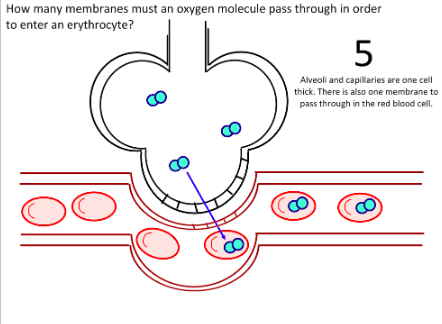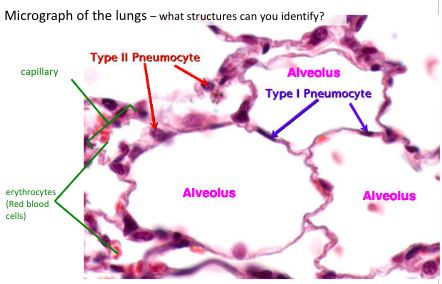Gas Exchange in humans
1/23
There's no tags or description
Looks like no tags are added yet.
Name | Mastery | Learn | Test | Matching | Spaced |
|---|
No study sessions yet.
24 Terms
The ventilation system
Ventilation (V) refers to the flow of air into and out of the alveoli, while perfusion (Q) refers to the flow of blood to alveolar capillaries
Parts of the ventilation system
trachea
bronchi
bronchioles
alveoli
lungs
diaphram
Exchange surfaces must:
permeability: be permeable to the substances that must pass across them.
Composed of thin tissue layer: be thin, so that there is a short distance for exchange by diffusion or other means.
Have a moist surface: be moist, so that materials can dissolve if necessary.
Large surface area: have a large surface area so there is maximum area for exchange.
Concentration gradient: have a means of maintaining a concentration gradient so that substances can flow down a gradient to where they are needed.
for diffusion to happen there needs to be a difference in concentration of the gas between two areas
Exchange surfaces must (acronymn)
SMART
Surface area
Moist
Absorptive
Rich blood system
Thin tissue layer
Concentration gradient
refers to the difference in concentration of a substance between two areas.
The bigger the difference in concentration, the steeper the concentration gradient, and the faster the rate of diffusion

Adaptations in the exchange surfaces of animals to maintain steep concentration gradients include:
dense network of blood vessels
continuous blood flow
ventilation
Why? a dense network of blood vessels
means that there is much opportunity for substances to be exchanged between the surface and the blood
Why? continuous blood flow
ensures that, as soon as substances move into the blood, they are transported away by the continuous blood flow,
ensuring a low concentration of that substance in the blood supply adjacent to the exchange surface
Why? ventilation
ensures the air or water rich in the desired gas is moved across the exchange surface.
Mammals inhale air into the lungs, and exhale to remove air from the lungs.
Why? Large surface area
the surface where exchange/diffusion takes place has large surface area- example villi in intestines, gills in fishes, alveoli in lungs etc
Breathing vs respiration
breathing = ventilation
movement of air in and out of the lungs (where gas exchange happens)
inspiration = inhale, expiration = exhale
Cell respiration
in the mitochondria of a cell
Alveoli and adaptations
alveoli increase their surface area for gas exchange
membranes are very tiny - both of alveoli and the capillaries - so the diffusion path is short
how many membranes must an oxygen molecule pass through to enter an erythrocyte?
5

type 2 vs type 1 pneumocyte (in the alveoli)
type 1
single layer of cells (at walls)
extremely thin
permeable (where exchange happens)
type 2
secrete fluid to moisten the inner surface of the alveolus
can divide to form type I pneumocytes

How does gas exchange happen?
Gas exchange occurs via a process called diffusion
gas exchange and surface area to volume ratio
As organisms increase in size, surface area-to-volume ratio decreases and there is a greater need for specialised structures to facilitate efficient gas exchange.
In such larger organisms, exchange across the body surface alone would not supply or remove gases efficiently.
alveoli characteristics
permeability
a moist surface for gases to diffuse
a large surface area
a short diffusion distance (thus thin wall)
As we exhale, what happens to the lung volume and lung pressure?
Lung volume decreases, pressure in the lungs increases.
When you exhale, air leaves the lungs. Think of what happens when you squeeze a balloon.
Inhalation/exhalation and pressure
Higher pressure in the lungs forces air out, lower pressure brings air in.
Pressure increases when volume decreases, pressure decreases when volume increases.
What happens to lung volume and lung pressure for the process of inhaling to occur?
Lung volume increases, pressure in the lungs decreases.
Describe inspiration
diaphram contracts
abdominal muscles relax
external intercostal muscles contract (ribcage up and out)
internal intercostal muscles relax
air pressure in thorax increases
volume of thoratic cavity decreases so that air can enter the lungs
Describe expiration
diaphram relaxes
abdominal muscles contract - pressure from abdominal muscles pushes diaphram into dome shape
external intercostal muscles relax
internal intercostal muscles contract (ribcage down and in)
air pressure in thorax decreases
volume of thoratic cavity increases so air leaves the lungs
trachea and bronchi role
The trachea and bronchi carry air to the alveoli in bronchioles in the lungs.
antagonistic muscles
External and internal intercostal muscles
diaphragm
abdominal muscles
required for inspiration and expiration because muscles only work by contracting.